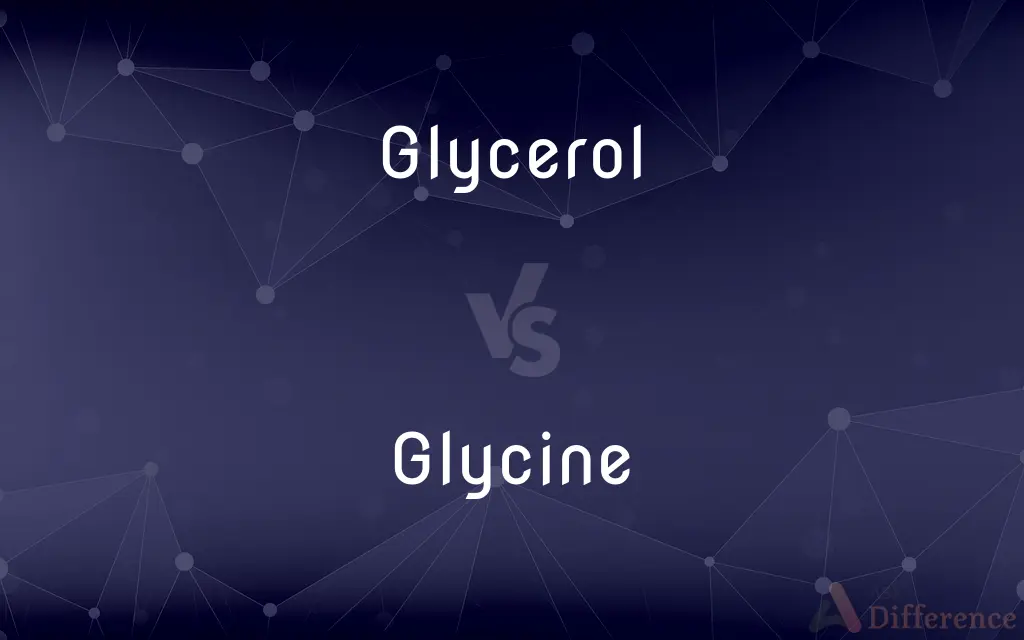Glycerol vs. Glycine — What's the Difference?
By Tayyaba Rehman — Updated on October 9, 2023
Glycerol is a sugar alcohol used in food and pharmaceuticals, while Glycine is an amino acid involved in protein synthesis.

Difference Between Glycerol and Glycine
Table of Contents
ADVERTISEMENT
Key Differences
Glycerol, a simple polyol compound, is a colorless, odorless, viscous liquid that is sweet-tasting and non-toxic. It has three hydroxyl groups that are responsible for its solubility in water and its hygroscopic nature. Glycine, in contrast, is the smallest amino acid in the constitution of proteins, possessing a hydrogen as its side chain. It’s non-essential, meaning the body can produce it, and it's involved in several key physiological processes.
Glycerol can be derived from both natural and synthetic sources and is a component of triglycerides, found in animal and plant fat. It’s used widely in the food industry as a sweetener and humectant and in pharmaceutical formulations. Glycine, found naturally in protein-rich foods, is not only pivotal in the creation of several other biological compounds but is also used in various industrial applications, such as in the production of pesticides.
The physical properties of glycerol, such as its viscosity and sweet taste, have seen it used in the food industry and in numerous consumer products. Furthermore, its characteristic of providing smoothness provides an application in skin and haircare products. On the other hand, Glycine, with its sweet taste and ability to inhibit muscle spasms, is utilized in antacids, and due to its simplicity and compact size, it plays roles in numerous biological functions.
In the realm of health, glycerol is sometimes administered medically to reduce pressure in the eye or to treat topical infections. Its presence is ubiquitous in skin-care products due to its moisturizing properties. Glycine, as a neurotransmitter in the nervous system, can have an impact on mental health and sleep patterns and is being studied for its possible roles in certain neurological conditions.
The biological roles of glycerol and glycine are both vital and varied. Where glycerol is key in triglyceride structure, thereby having a role in energy storage, glycine is involved in the synthesis of several essential biological compounds, including proteins, purines, and porphyrins, demonstrating a foundational role in life processes.
ADVERTISEMENT
Comparison Chart
Basic Definition
A sugar alcohol compound.
An amino acid.
Role in Biology
Part of triglyceride structure.
Involved in protein synthesis.
Applications
Used in food and pharmaceuticals.
Used in biology and industry.
Physical State
Viscous liquid.
Solid (crystalline powder).
Taste
Sweet.
Sweet.
Compare with Definitions
Glycerol
A hygroscopic sugar alcohol.
Glycerol is often used to retain moisture in food products.
Glycine
A neurotransmitter.
Glycine can modulate neuronal activity in the brain.
Glycerol
A component of triglycerides.
Glycerol is released when triglycerides are broken down.
Glycine
The smallest amino acid.
Glycine’s tiny size allows it to fit into tight molecular spaces.
Glycerol
A common cosmetic ingredient.
Glycerol is added to lotions for its moisturizing effect.
Glycine
A non-essential amino acid.
The human body can synthesize glycine on its own.
Glycerol
Glycerol (; also called glycerine in British English or glycerin in American English) is a simple polyol compound. It is a colorless, odorless, viscous liquid that is sweet-tasting and non-toxic.
Glycine
A component in industrial applications.
Glycine is utilized in the production of certain herbicides.
Glycerol
A colourless, sweet, viscous liquid formed as a by-product in soap manufacture. It is used as an emollient and laxative, and for making explosives and antifreeze.
Glycine
Involved in hemoglobin production.
Glycine participates in producing porphyrin for hemoglobin.
Glycerol
A syrupy, sweet, colorless or yellowish liquid triol, C3H8O3, obtained from fats and oils as a byproduct of saponification and used as a solvent, antifreeze, plasticizer, and sweetener and in the manufacture of dynamite, cosmetics, liquid soaps, inks, and lubricants.
Glycine
Glycine (symbol Gly or G; ) is an amino acid that has a single hydrogen atom as its side chain. It is the simplest stable amino acid (carbamic acid is unstable), with the chemical formula NH2‐CH2‐COOH. Glycine is one of the proteinogenic amino acids.
Glycerol
(organic compound) 1,2,3-trihydroxy-propane or propan-1,2,3-triol; a trihydric alcohol
Glycine
A sweet-tasting crystalline nonessential amino acid, C2H5NO2, that is the principal amino acid occurring in sugarcane. The simplest amino acid found in protein, it is derived from the alkaline hydrolysis of gelatin and used in biochemical research and medicine.
Glycerol
A syrupy sweet liquid obtained as a by-product in the manufacture of soap from animal or vegetable oils and fats; it is used as an antifreeze, a plasticizer, and a food sweetener and in the manufacture of dynamite, cosmetics etc.
Glycine
(amino acid) A nonessential amino acid, amino-acetic acid, C2H5NO2 found in most proteins but especially in sugar cane; the simplest amino acid.
Glycerol
Same as Glycerin.
Glycine
The simplest amino acid found in proteins and the principal amino acid in sugar cane
Glycerol
A sweet syrupy trihydroxy alcohol obtained by saponification of fats and oils
Glycine
Genus of Asiatic erect or sprawling herbs: soya bean
Glycerol
Used in medical and laboratory settings.
Glycerol is used in cryopreservation to prevent ice crystal formation.
Glycerol
A sweetener in the food industry.
Glycerol adds sweetness to low-sugar candies.
Common Curiosities
Can Glycerol be used as a sweetener?
Yes, Glycerol is often used as a sweetener in various foods.
What foods are rich in Glycine?
Foods like fish, meat, dairy, and legumes are rich in Glycine.
Can Glycerol be applied topically?
Yes, Glycerol is often found in skincare products due to its moisturizing properties.
Is Glycine essential or non-essential?
Glycine is a non-essential amino acid.
Is Glycerol safe for consumption?
Yes, Glycerol is generally recognized as safe when used in food.
How is Glycine synthesized in the body?
Glycine is synthesized from serine, a different amino acid.
What are the primary sources of Glycine?
Glycine is found in protein-rich foods and can be synthesized by the body.
What is the basic function of Glycerol in the body?
Glycerol is a backbone of triglycerides, aiding in energy storage.
What role does Glycine play in the nervous system?
Glycine acts as a neurotransmitter in the central nervous system.
What role does Glycerol play in fermentation?
Glycerol is produced during fermentation and can affect the taste and mouthfeel of wines.
How does Glycerol interact with fats?
Glycerol combines with fatty acids to form triglycerides.
Can Glycine help improve sleep quality?
Some research indicates Glycine may have a positive impact on sleep quality.
Is Glycine used in any industrial processes?
Yes, Glycine is used in various industrial applications, such as pesticide production.
What role does Glycerol play in baked goods?
Glycerol acts as a humectant, helping retain moisture in baked goods.
Is Glycerol found naturally in the body?
Yes, Glycerol is present naturally, especially in fat stores.
Share Your Discovery

Previous Comparison
Marriage vs. Solemnization
Next Comparison
Harassment vs. AbuseAuthor Spotlight
Written by
Tayyaba RehmanTayyaba Rehman is a distinguished writer, currently serving as a primary contributor to askdifference.com. As a researcher in semantics and etymology, Tayyaba's passion for the complexity of languages and their distinctions has found a perfect home on the platform. Tayyaba delves into the intricacies of language, distinguishing between commonly confused words and phrases, thereby providing clarity for readers worldwide.














































